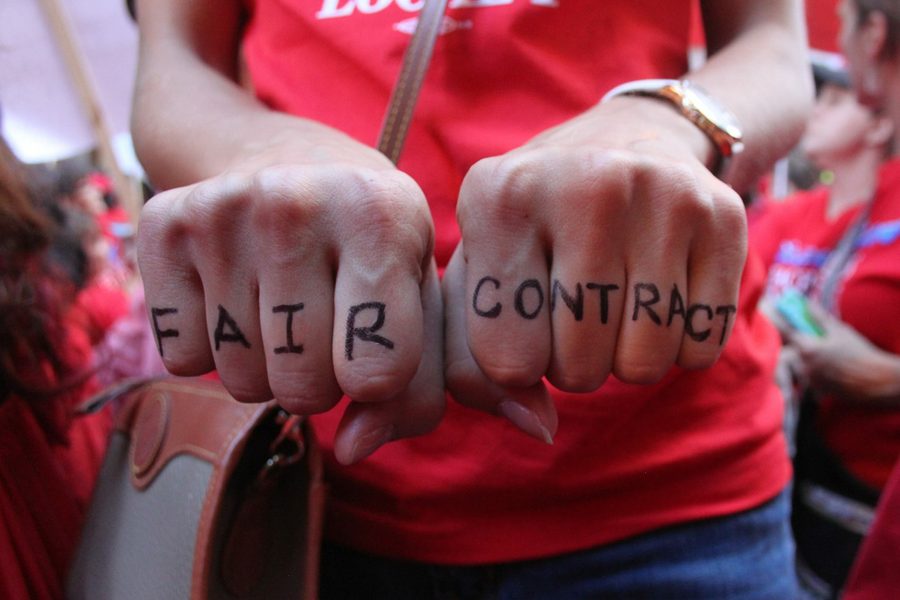The Two-Tier Provision in the Chicago Teachers Union’s Tentative Agreement, Explained
Shaun Richman

The tentative agreement that the Chicago Teachers Union (CTU) struck with district management less than an hour before a midnight October 10 strike deadline has been hailed by many as a victory. Facing another round of concessionary demands, the union managed to extract $88 million from the mayor’s corporate slush fund to restore some badly needed funding to the school system. The union also managed to win an increase in compensation.
But the way that the compensation is structured — with current teachers keeping their current 7 percent pension “pickup,” and new hires receiving a salary increase in lieu of a pension contribution — has some critics decrying the deal as a solidarity-killing, two-tier contract. A pickup is the percentage of a worker’s pay that an employer puts directly into a pension fund.
The CTU’s House of Delegates meets Wednesday to deliberate over the tentative agreement and vote on whether to send it to the entire membership for ratification. If the deal is rejected, there is no guarantee that management will agree to more of the union’s demands — or even return to the table.
Two-tier contracts are an emotional subject in the labor movement. Beginning in the 1980s, employers used threats of off-shoring and sub-contracting, as well as their legal “right” to permanently replace striking union members, to force a wave of wage and benefit givebacks across many unionized industries. In order to make these cuts more palatable to the members who would have to vote on their ratification, unions negotiated agreements where current workers preserved most of their pay and benefits while future hires would bear the brunt of the cuts.
There are many epithets for this sort of thing, but the most common may be selling out the unborn. These ticking time bombs blow up years later, as the “new” hires become a larger portion of the bargaining unit and resent their veteran colleagues both for their more generous compensation packages and for the fact that the older workers signed away their younger colleagues’ right to enjoy the same. As the veterans become a minority in the workplace, there is an obvious financial incentive for supervisors to push them out through aggressive discipline. In such a situation, worker unity in future rounds of bargaining is hard to achieve.
To be clear, not all “two-tiers” are alike. The powerful New York Hotel and Motel Trades Council accepted a two-tier wage structure after surviving a 27-day strike in 1985. But the tiers only impacted workers during their first year of employment. By year two, all workers were earning the same pay rate. And, decades later, ending the tiered pay scale remained a union bargaining priority.
The United Automobile Workers (UAW) accepted a two-tier pay scale at Chrysler when the company went bankrupt in 2009. It was so severe that new hires earned only half the hourly wage of veteran employees. When members voted down a 2015 successor agreement that did not go far enough in reversing the double standard, the UAW was able to renegotiate a deal that brings newer workers closer to the traditional pay scale over the course of seven years.
The CTU’s proposed “two-tier” is a bit more of a shell game than those concessions. The fight over Chicago’s 7 percent pension pickup has more to do with symbolism than anyone’s actual paycheck. Pension systems are complicated things that only accountants and union researchers fully understand. But basically, a pension fund needs a certain amount of money coming in every year in order to guarantee a livable retirement income for actual and projected retirees. Currently, the Chicago Teachers Pension Fund has set that target at 9 percent of every pension-eligible employee’s annual income.
Before the CTU won collective bargaining rights in the 1960s, teachers had most, if not all, of their pension contributions deducted directly from their paychecks. Over the years, the CTU was able to bargain for 7 of that 9 percent to be contributed directly into the pension fund, instead of paid as a salary increase and then immediately deducted as a personal pension contribution.
Obviously, the difference between putting 7 percent in pension contributions directly versus rolling it into salaries, and then immediately deducting it, makes no financial difference to the employer. But the 7 percent became a visible target for Gov. Bruce Rauner and Mayor Rahm Emanuel. It was money they could portray to the public and the press as “extra” compensation that teachers get that other workers don’t and demand that teachers give it up. (It should be noted that Chicago teachers aren’t eligible for Social Security, so their pensions are the only thing that stand between them and an old age spent subsisting on cat food.)
Under the tentative agreement the CTU is considering, the pay for new hires would increase by an additional 3.5 percent in two successive years. It’s not entirely clear how soon new hires would be responsible for paying the full pension contribution.
Teachers at charter schools also participate in the Chicago Teachers Pension Fund. Members of the Chicago Alliance of Charter Teachers and Staff (Chicago ACTS) at the UNO Charter School Network (UCSN) are currently bargaining over the very same pension pickup, and have set a Wednesday strike deadline.
I was a part of the bargaining team that negotiated the first contract at UCSN in 2013. Because we had a significant amount of bargaining leverage in the wake of a very public insider dealing scandal, we realized that those negotiations were our best shot to get the charter network to pay more than the whole lot of nothing that it had been contributing to teachers’ pensions.
We were successful. That 7 percent was a part of an overall compensation package we were going to win anyway. But by directing the employer to put it towards the pension, we politicized a different figure: the network’s starting salaries. Because charters compete in the same labor market as the district to recruit new teachers, the salaries they can offer are key. If that 7 percent had simply been rolled into base pay, UCSN would be able to quote starting salaries that appear to be larger than what the district offers, but really aren’t, giving the union leverage to raise wages in future negotiations. Now that starting salaries at Chicago Public Schools will appear to be 7 percent larger—if CTU members ratify the deal — the salaries that UCSN offers will appear even less competitive.
As for ratification of their contract, CTU members have to decide how important the symbolism of that 7 percent is and what impact it will have on future rounds of negotiations. The shifting of that 7 percent from one column in a spreadsheet to another strikes me as a last minute ploy to give Rauner and Emanuel a face-saving narrative that allows them to say they didn’t suffer a humiliating defeat in this round of bargaining.
“This is not a perfect agreement,” said CTU president Karen Lewis. “But it is good for the kids. And good for the clinicians. And good for the teachers, and the paraprofessionals.”
Shaun Richman is a labor expert at SUNY Empire State University and author of Tell The Bosses We’re Coming: A New Action Plan for Workers in the 21st Century.








